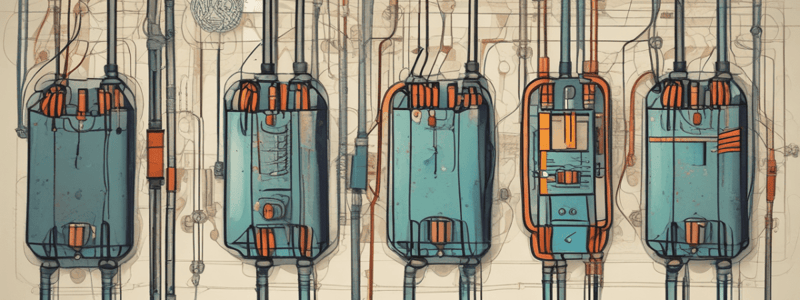Podcast
Questions and Answers
What is the relationship between voltage and current in determining the resistance of an object?
What is the relationship between voltage and current in determining the resistance of an object?
The resistance of an object is the ratio of voltage across it to the current through it.
What is the unit of measurement for resistance in SI Units?
What is the unit of measurement for resistance in SI Units?
Ohm (Ω)
What happens to a material as electricity flows through it?
What happens to a material as electricity flows through it?
It heats up.
What is a type of resistor whose resistance can be varied?
What is a type of resistor whose resistance can be varied?
What is the formula that describes the relationship between voltage, current, and resistance in a conductor?
What is the formula that describes the relationship between voltage, current, and resistance in a conductor?
What is the S.I. unit of power, and what is it equivalent to?
What is the S.I. unit of power, and what is it equivalent to?
What is the formula that relates power to voltage and current?
What is the formula that relates power to voltage and current?
What instrument can be used to measure the resistance of a conductor?
What instrument can be used to measure the resistance of a conductor?
Why is it advantageous to use high-voltage transmission lines for electrical power distribution?
Why is it advantageous to use high-voltage transmission lines for electrical power distribution?
In a series circuit, what is the characteristic of the current at every point along the wire?
In a series circuit, what is the characteristic of the current at every point along the wire?
What is the relationship between current and voltage in a transmission line, and how does it affect heat production?
What is the relationship between current and voltage in a transmission line, and how does it affect heat production?
How does the current change in parallel parts of a circuit, and what is the condition at the junctions?
How does the current change in parallel parts of a circuit, and what is the condition at the junctions?
What is the underlying principle that explains why high-voltage transmission lines are more efficient than low-voltage lines?
What is the underlying principle that explains why high-voltage transmission lines are more efficient than low-voltage lines?
In a parallel circuit, what is the relationship between the total current and the currents in each branch?
In a parallel circuit, what is the relationship between the total current and the currents in each branch?
What is the formula for the total resistance of resistors in series?
What is the formula for the total resistance of resistors in series?
How do the potential differences of the individual components in a circuit relate to the total potential difference of the circuit?
How do the potential differences of the individual components in a circuit relate to the total potential difference of the circuit?
What is the formula for the total resistance of resistors in parallel?
What is the formula for the total resistance of resistors in parallel?
What is the relationship between the currents entering and leaving a point in a parallel circuit?
What is the relationship between the currents entering and leaving a point in a parallel circuit?
What is the physical quantity that is affected by the resistivity, length, and cross-sectional area of a conductor?
What is the physical quantity that is affected by the resistivity, length, and cross-sectional area of a conductor?
What are wheatstone bridges used for and what is the fundamental formula about them?
What are wheatstone bridges used for and what is the fundamental formula about them?
What are the factors that affect the resistance of a metallic conductor?
What are the factors that affect the resistance of a metallic conductor?
What is the SI unit of resistivity?
What is the SI unit of resistivity?
What is the relationship between the resistance of a body and its resistivity, length, and cross-sectional area?
What is the relationship between the resistance of a body and its resistivity, length, and cross-sectional area?




